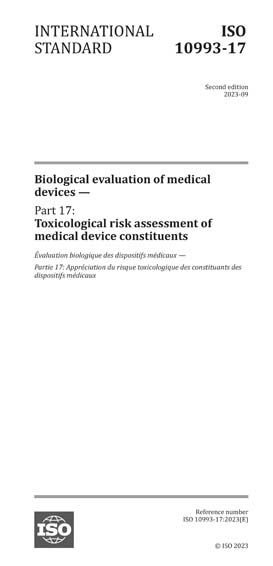Most recent
ISO 10993-17:2023
Biological evaluation of medical devices - Part 17: Toxicological risk assessment of medical device constituents
This document specifies the process and requirements for the toxicological risk assessment of medical device constituents. The methods and criteria used to assess whether exposure to a constituent is without appreciable harm are also specified. The toxicological risk assessment can be part of the biological evaluation of the final product, as described in ISO 10993-1.
The process described in this document applies to chemical characterization information obtained in line with ISO 10993-18. When a toxicological risk assessment of either the compositional information or analytical chemistry data (e.g. extractable data or leachable data) are required to determine whether the toxicological risks related to the constituents are negligible or tolerable.
The process described in this document is not intended to apply to circumstances where the toxicological risk has been estimated by other means, such as:
— constituents, excluding cohort of concern or excluded chemicals, that are present in or extracted from a medical device at an amount representative of patient exposure below a relevant, toxicologically-based reporting threshold (see applicable requirements in ISO 10993-18:2020, Annex E and ISO/TS 21726);
— a new or changed medical device for which chemical or biological equivalence has been established with an existing biocompatible or clinically established medical device (see applicable requirements in ISO 10993-18:2020, Annex C).
The process described in this document is also not applicable to:
— medical device constituents that do not contact the body (e.g. in vitro diagnostics);
— biological risks associated with physical interactions of the medical device with the body (i.e. application of mechanical forces, energy or surface morphology, etc.), provided that the chemical exposure is not changed;
— active pharmaceutical ingredients of device-drug combination products or biologic components of device-biologic combination products as additional regulatory considerations can apply;
— exposure to a particular constituent that arises from sources other than the device, such as food, water or air.
International Organization for Standardization [iso]


